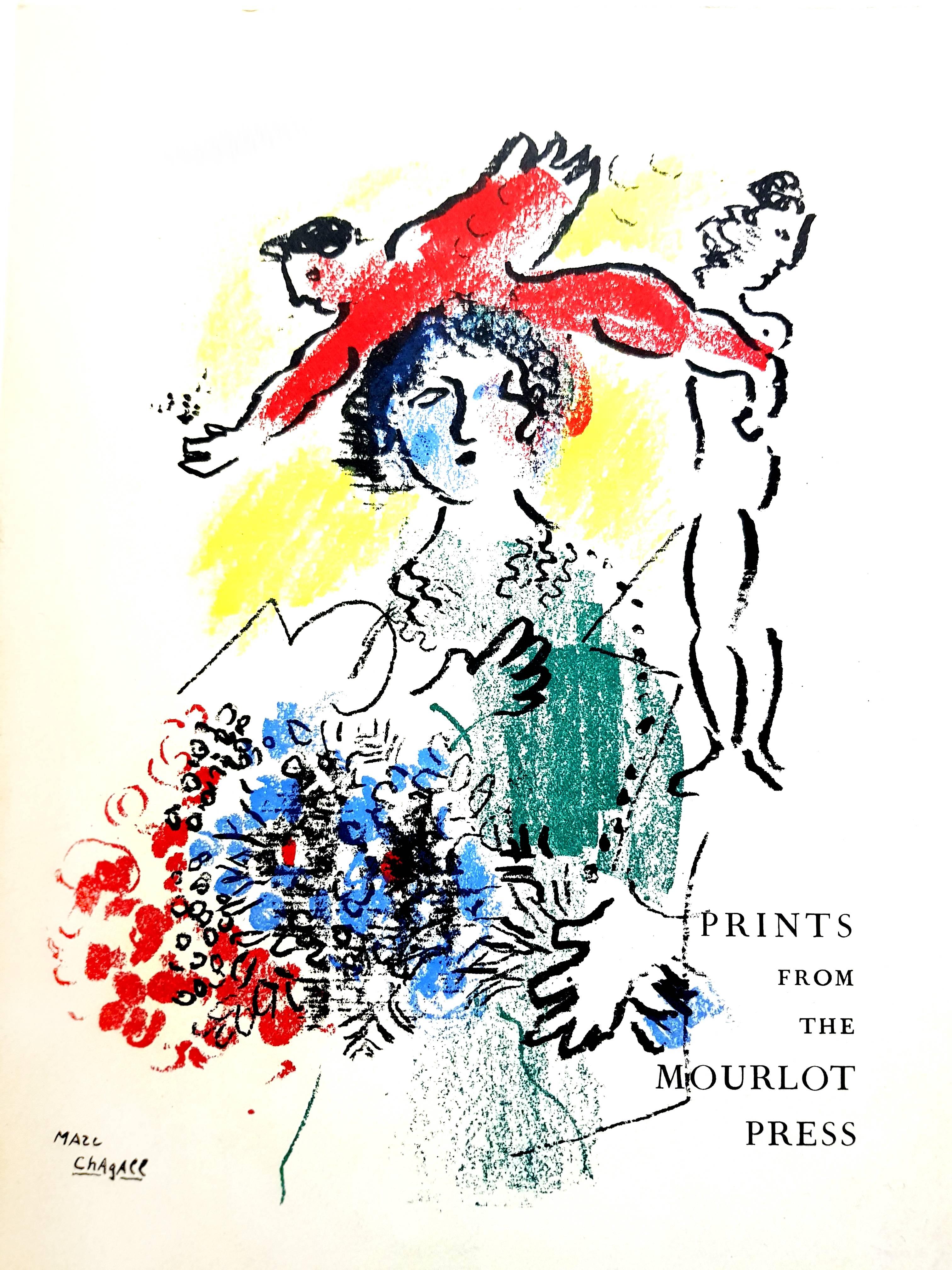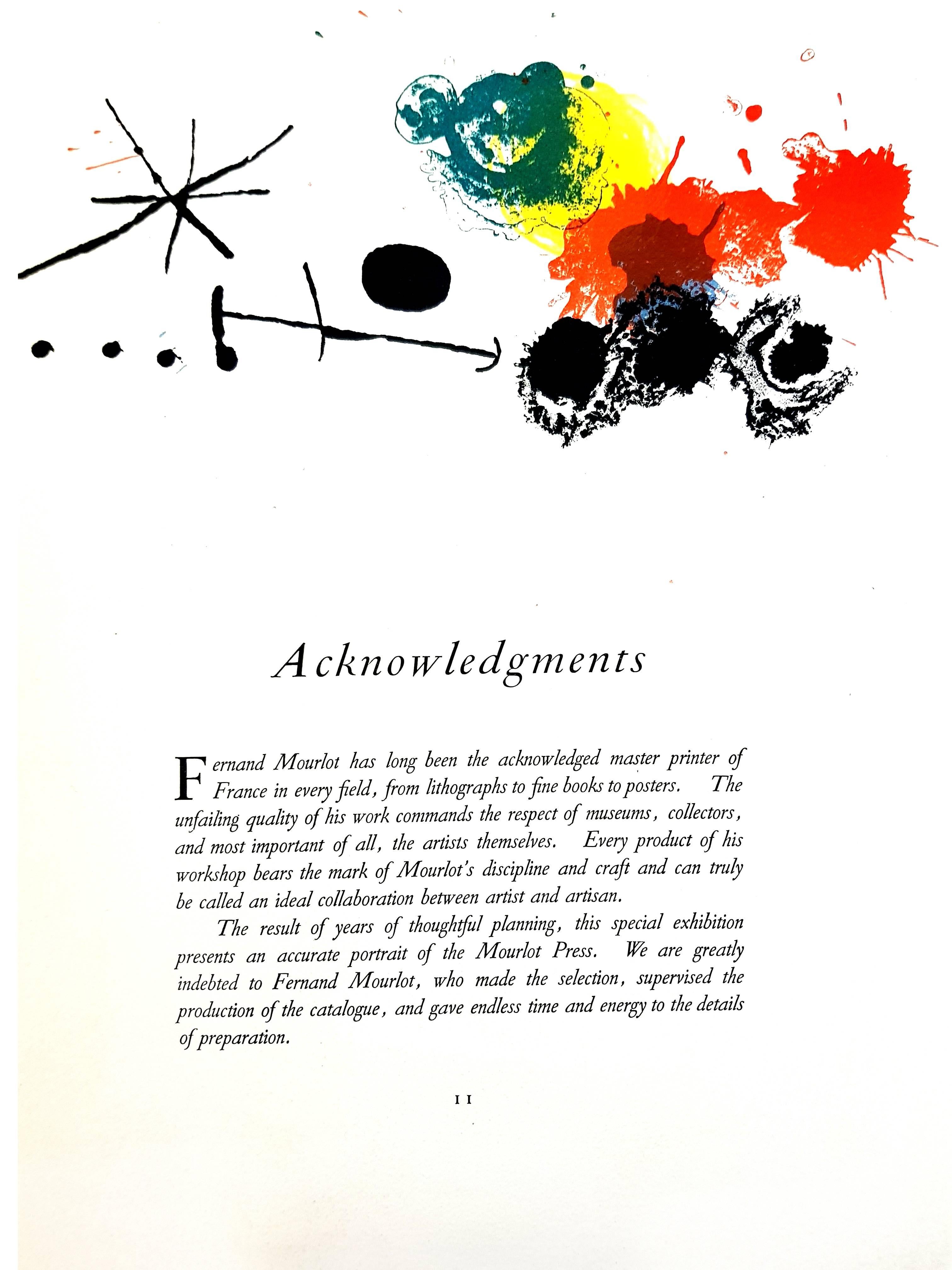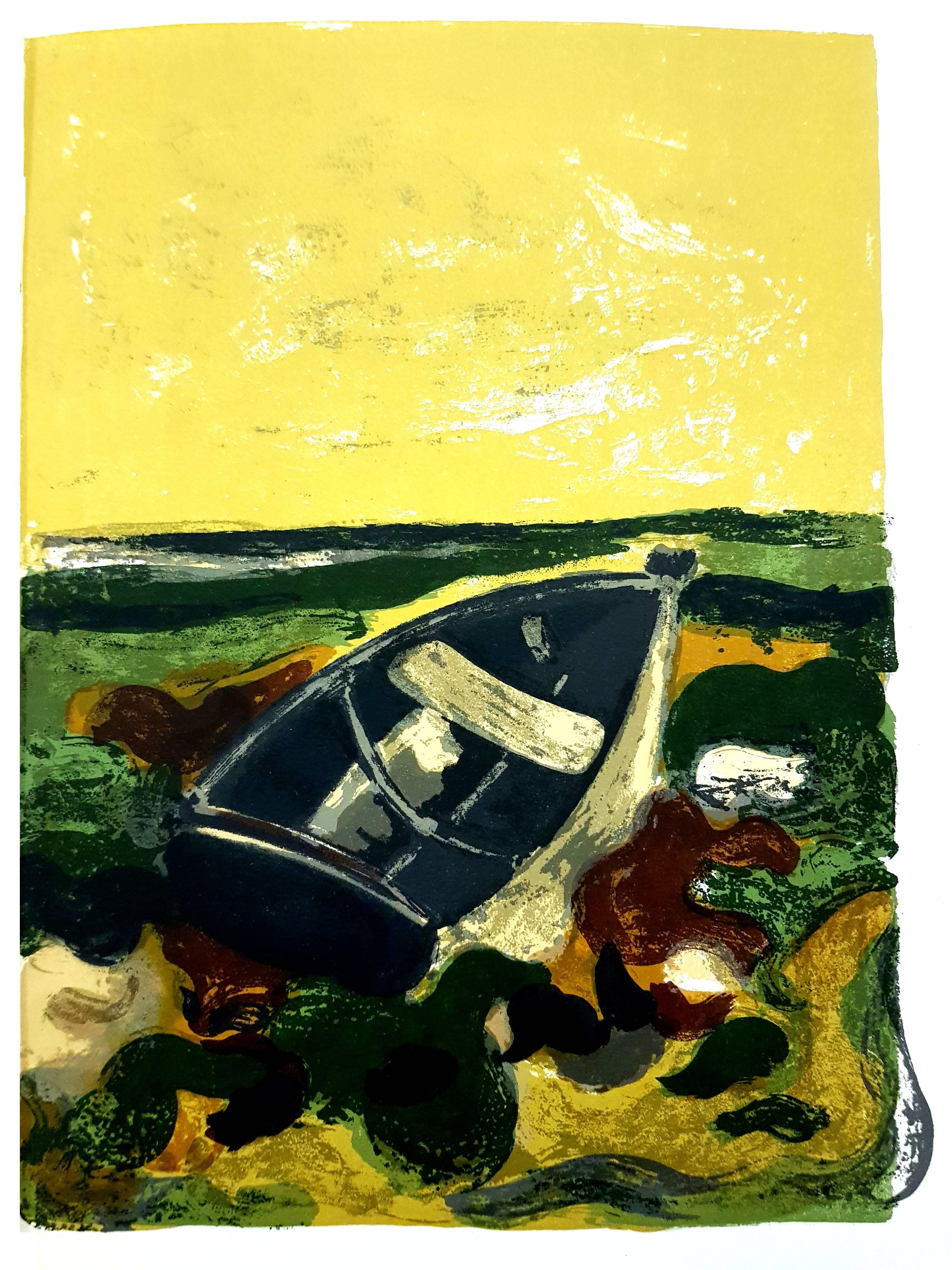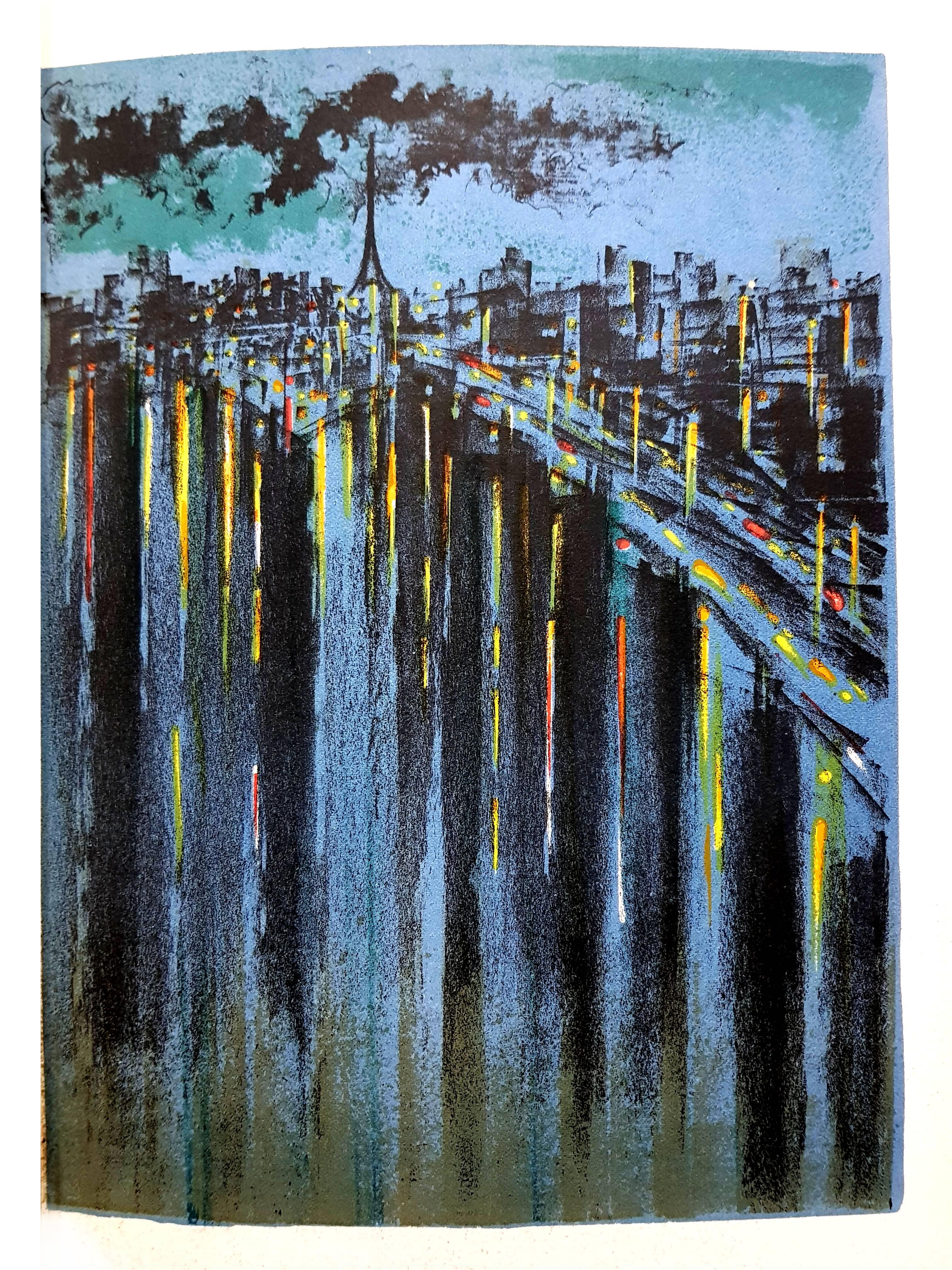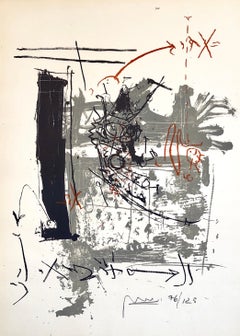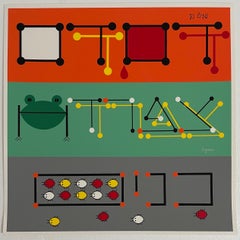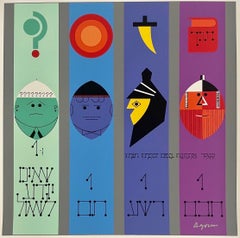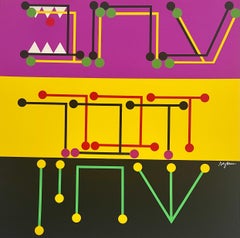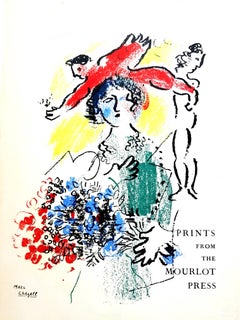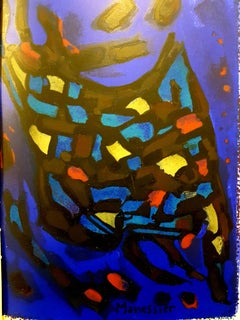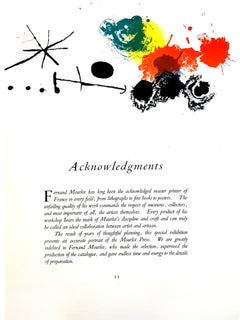Items Similar to Israeli Josef Zaritsky Abstract Modernist Lithograph Print "Composition"
Want more images or videos?
Request additional images or videos from the seller
1 of 9
Igael TumarkinIsraeli Josef Zaritsky Abstract Modernist Lithograph Print "Composition"c.1959
c.1959
About the Item
Abstract Composition, 1959 Lithograph
This was from a portfolio which included works by Yosl Bergner, Menashe Kadishman, Yosef Zaritsky, Aharon Kahana, Moshe Tamir and Michael Gross.
Joseph (Yossef) Zaritsky (Hebrew: יוסף זריצקי; September 1, 1891 – November 30, 1985) was one of Israel's greatest artists and one of the early promoters of modern art in the Land of Israel both during the period of the Yishuv (Palestine, the body of Jewish residents in the Land of Israel before the establishment of the State of Israel) and after the establishment of the State. In 1948 Zaritsky was one of the founders of the "Ofakim Hadashim" group. In his works he created a uniquely Israeli style of abstract art, which he sought to promote by means of the group. For this work he was awarded the Israel Prize for painting in 1959.
Joseph Zaritsky was born in 1891 in Borispol, in the Poltava Oblast (province), in the Southwestern portion of the Russian Empire (today the Kiev Oblast of the Ukraine), to a large, traditional Jewish family. His parents, Golda and Joseph Ben Ya'acov, were farmers with National-Zionist leanings. One of the main expressions of this was their devoting of two rooms in their home to the study of Hebrew and reading. From 1910 to 1914 he studied art at the Academy of Arts in the city of Kiev. Among the artists that influenced Zaritsky was the Russian Symbolist painter Mikhail Vrubel. In 1915, during World War I, Zaritsky was conscripted into the Russian Army, where he served until 1917.
Because of the pogrom of 1919, the family escaped to Kalarash, Bessarabia, leaving behind all his works and art up to that point. In Kalarash he stayed in his father-in-law's home, where he painted small-scale watercolors, of which only five have survived: three portraits of his wife and two rural landscapes. These small works are done in small dark colored dots, and they reflect the influence of Russian modernism. Zaritsky divided the format into a sort of mosaic on small canvases that blur the illusion of perspective.
In 1924 Zaritsky mounted his first solo exhibition in the club "Menorah" in Jerusalem. Another exhibition was opened in the Technion in Haifa. Zaritsky and the sculptor Abraham Melnikov, were the initiators of the first of the exhibitions of Israeli artists in the Tower of David. Also, from 1927 he served as the Chairman of the Israel Painters and Sculptors Association.
In the middle of the 1920s Zaritsky moved to Tel Aviv and continued to paint the series of landscapes that he had started in Jerusalem. The landscapes and portraits of that he painted during these years show his effort to create an artistic language appropriate to description.
In 1927 Zaritsky left his family behind and went to Paris for a stay of several months.
In 1929 Zaritsky participated in the "Egged" group's exhibition, held in an apartment on Allenby Street in Tel Aviv, in which artists such as Sionah Tagger, Arieh Lubin, and Pinchas Litvinovsky, among others, also participated. The works of this group show the influence of late French post-modernism (primarily of the "School of Paris"), which was popular among the artists of the Land of Israel. The exhibition "The Bezalel National Museum" in 1930 placed him firmly in the public consciousness as a modernist artist. “Even the red curtain," Greenberg writes, "which in his paintings reminds us of the abstraction of Kandinsky, even this red is restrained, and its judgment as red becomes just a matter of a wintry sunset."
Between 1932 and 1933, Zaritsky opened an art "studia" adjoining the basement of the home where he lived on 18 Mapu Street. Among the artists who came to his studio were Yehiel Krize, Arie Aroch. Zaritsky’s watercolor paintings – a unique interpretation of Cézanne and of the Russian symbolist painting (Vrubel) – received recognition from the moment of his aliyah in 1923. Joseph Zaritsky's still lifes and portraits from the end of the 1920s and the 1930s, show the influence of French intimiste painting and sometimes of Matisse. From the middle of the 1930s to the middle of the 1940s Zaritsky concentrated on describing one urban landscape – the view of Tel Aviv roofs from the window of his studio or from the roof of his house. These works of Zaritsky’s are a milestone in the history of Israeli art both because of their high quality and because they represent an important stage in Zaritsky’s movement toward abstraction. They represent the influence of French art in the 1930s. They also relate to the modernist, contemporary aspect of the modern architecture of Tel Aviv, and to painting for its own sake and not to a figurative theme. The level of sophistication and the depth with which he dealt with the principles of painting are milestones in themselves. Artists such as Pinchas Abramovich, Yehiel Krize, Arie Aroch, and Shimshon Holzman were all pupils of Zaritsky during those years. And in addition to them, he had a great influence on many other artists. Zaritsky turned his gaze away from the view of the beach which occupied his contemporaries, like Nahum Gutman, Reuven Rubin, etc., to views of the new, modern city spread out to his north and east. In 1941 he mounted a solo exhibition in the Habima building in honor of his 50th birthday. In 1942 Zaritsky won the Dizengoff Prize for Painting.
The motive behind the founding of an alternative to the general art association came into being in 1948, with an invitation to mount an exhibition of Israeli artists at the Italian pavilion of the Venice Biennale. On November 9, 1948 the new group mounted an exhibition of 18 member artists in the Tel Aviv Museum of Art, under the name "New Horizons." While artists such as Yohanan Simon, Moshe Castel, and Marcel Janco dealt with Zionist and Jewish symbolism, Zaritsky chose for the exhibition an abstract still life influenced by the cubist painter Georges Braque.
In 1957 the government of Israel decided to put on a large national display in honor of the tenth anniversary of the founding of the State of Israel. Among the outstanding works were a large steel sculpture by Yechiel Shemi, "Sculpture of the Decade" by Itzhak Danziger , a frieze by Yaakov Wechsler, etc. Another notable work was Zaritsky's painting "Otsma" (Power), which had been commissioned by Avraham Yaski, a designer in the "Department of Economic Achievements."
In the 1980s Zaritsky would take up residence every summer in the studio he had received on Kibbutz Tzuba. At Tzuba he would paint watercolors, among them abstract nature paintings, from direct contemplation of nature. In the summer of 1983, Zaritsky painted a number of paintings in the studio in which he returned to the motif of the window, which he had used in the past. In addition, in the 1980s Zaritsky created a number of paintings, some of them monumental in size, constructed along the lines of painters like Goya, Pablo Picasso, Marc Chagall, etc.
In 1980 one of Zaritsky's watercolors from 1924 was sold at a public auction in the Gordon Gallery for $79,000. In 1979 he was interviewed on television for the first time on Gideon Ofrat's show "Taste and Smell." In 1981 the Israeli Postal Authority issued a stamp depicting Zaritsky’s “Jerusalem: The View from Jaffa Gate” (1927). In 1981 Marc Scheps, Director of the Tel Aviv Museum of Art, named Zaritsky recipient of the Yakir Ha'ir (Esteemed of the City) award; In January 1982 there was a festive screening of the film "Portrait of an Artist: Joseph Zaritsky” (1981; 32 min.), directed by Jachin Hirsch, under the auspices of the Ministry of Education and the Israel Film Service. In 1985 the Tel Aviv Museum Art hosted a retrospective exhibition of Zaritsky’s art that included 340 of his works.
- Creator:Igael Tumarkin (1933, German, Israeli)
- Creation Year:c.1959
- Dimensions:Height: 20 in (50.8 cm)Width: 27 in (68.58 cm)Depth: 2 in (5.08 cm)
- Medium:
- Movement & Style:
- Period:
- Condition:minor wear, please see photos.
- Gallery Location:Surfside, FL
- Reference Number:1stDibs: LU38214372972
About the Seller
4.9
Platinum Seller
Premium sellers with a 4.7+ rating and 24-hour response times
Established in 1995
1stDibs seller since 2014
1,744 sales on 1stDibs
Typical response time: 2 hours
- ShippingRetrieving quote...Shipping from: Surfside, FL
- Return Policy
Authenticity Guarantee
In the unlikely event there’s an issue with an item’s authenticity, contact us within 1 year for a full refund. DetailsMoney-Back Guarantee
If your item is not as described, is damaged in transit, or does not arrive, contact us within 7 days for a full refund. Details24-Hour Cancellation
You have a 24-hour grace period in which to reconsider your purchase, with no questions asked.Vetted Professional Sellers
Our world-class sellers must adhere to strict standards for service and quality, maintaining the integrity of our listings.Price-Match Guarantee
If you find that a seller listed the same item for a lower price elsewhere, we’ll match it.Trusted Global Delivery
Our best-in-class carrier network provides specialized shipping options worldwide, including custom delivery.More From This Seller
View AllIsraeli Tumarkin Abstract Modernist Graffiti Art Lithograph Print "Broken Hour"
Located in Surfside, FL
This was from a portfolio which included works by Yosl Bergner, Menashe Kadishman, Yosef Zaritsky, Aharon Kahana, Moshe Tamir and Michael Gross.
Yigal Tumarkin (also Igael Tumarkin...
Category
1950s Modern Abstract Prints
Materials
Lithograph
Agam Silkscreen Mod Judaica Lithograph Hand Signed Israeli Kinetic Op Art Print
By Yaacov Agam
Located in Surfside, FL
Yaacov Agam
Israeli (b. 1928)
Hand signed, not individually numbered but from edition of 180. I can include a copy of the title sheet with the edition size and his signature if you request.
sheet: 13.5 X 13.5 inches
Some of these works have beautiful Hebrew calligraphy and mod imagery, animals, children and such that are not usually found in his work. This is a masterpiece of bold, graphic, mod design. Along with Reuven Rubin and Menashe Kadishman he is among Israel's best known artists internationally.
Biographical info: The son of a rabbi, Yaacov Agam can trace his ancestry back six generations to the founder of the Chabad movement in Judaism. in 1946, he entered the Bezalel Academy of Arts and Design in Jerusalem. Studying with Mordecai Ardon, a former student at the Weimar Bauhaus. Yaakov Agam has been associated h with “abstract” artists, “hard edge” artists, and artists such as Josef Albers and Max Bill. Others find in Agam’s work an indebtedness to the masters of the Bauhaus. Agam’s approach to art, being conceptual in nature, has been likened to Marcel Duchamp’s, who expressed the need to put art “at the service of the spirit.” And, because of Agam’s employment of color and motion in his art, he has been compared to Alexander Calder, the artist who put sculpture into motion. (Motion is not an end, but a means for Agam. Calder’s mobiles are structures that are fixed, revolving at the whim of the wind. In a work by Agam, the viewer must intervene.) Agam has also been classified as an “op art” artist because he excels in playing with our visual sensitivities. Agam went to Zurich to study with Johannes Itten at the Kunstgewerbeschule. There, he met Frank Lloyd Wright and Siegfried Giedion, whose ideas on the element of time in art and architecture impressed him. In 1955, Galerie Denise René hosted a major group exhibition in connection with Vasarely's painting experiments with movement. in addition to art by Vasarely, it included works by Yaacov Agam, Pol Bury, Soto and Jean Tinguely, among others. Most Americans were first introduced to Vasarely by the groundbreaking exhibition, "The Responsive Eye," at New York's Museum of Modern Art in 1965. Josef Albers, Richard Anuszkiewicz. The show confirmed Vasarely's international reputation as the father of Op art. Agam has sought to express his ideas in a non-static form of art. In his abstract Kinetic works, which range from paintings and graphics to sculptural installations and building facades. Agam continually seeks to explore new possibilities in form and color and to involve the viewer in all aspects of the artistic process. Thus, for the past 40 years, Yaacov Agam’s pioneering ideas have impacted developments in art, (painting, monoprint, lithograph and agamograph) architecture, theatre, and public sculpture. Reflecting both his Israeli Jewish...
Category
1980s Op Art Abstract Prints
Materials
Lithograph, Screen
Agam Silkscreen Mod Judaica Lithograph Hand Signed Israeli Kinetic Op Art Print
By Yaacov Agam
Located in Surfside, FL
Yaacov Agam
Israeli (b. 1928)
Hand signed, not individually numbered but from edition of 180. I can include a copy of the title sheet with the edition size and his signature if you request.
sheet: 13.5 X 13.5 inches
Some of these works have beautiful Hebrew calligraphy and mod imagery, animals and such that are not usually found in his work. This is a masterpiece of bold, graphic, mod design. Along with Reuven Rubin and Menashe Kadishman he is among Israel's best known artists internationally.
Biographical info: The son of a rabbi, Yaacov Agam can trace his ancestry back six generations to the founder of the Chabad movement in Judaism. in 1946, he entered the Bezalel Academy of Arts and Design in Jerusalem. Studying with Mordecai Ardon, a former student at the Weimar Bauhaus. Yaakov Agam has been associated h with “abstract” artists, “hard edge” artists, and artists such as Josef Albers and Max Bill. Others find in Agam’s work an indebtedness to the masters of the Bauhaus. Agam’s approach to art, being conceptual in nature, has been likened to Marcel Duchamp’s, who expressed the need to put art “at the service of the spirit.” And, because of Agam’s employment of color and motion in his art, he has been compared to Alexander Calder, the artist who put sculpture into motion. (Motion is not an end, but a means for Agam. Calder’s mobiles are structures that are fixed, revolving at the whim of the wind. In a work by Agam, the viewer must intervene.) Agam has also been classified as an “op art” artist because he excels in playing with our visual sensitivities. Agam went to Zurich to study with Johannes Itten at the Kunstgewerbeschule. There, he met Frank Lloyd Wright and Siegfried Giedion, whose ideas on the element of time in art and architecture impressed him. In 1955, Galerie Denise René hosted a major group exhibition in connection with Vasarely's painting experiments with movement. in addition to art by Vasarely, it included works by Yaacov Agam, Pol Bury, Soto and Jean Tinguely, among others. Most Americans were first introduced to Vasarely by the groundbreaking exhibition, "The Responsive Eye," at New York's Museum of Modern Art in 1965. Josef Albers, Richard Anuszkiewicz. The show confirmed Vasarely's international reputation as the father of Op art. Agam has sought to express his ideas in a non-static form of art. In his abstract Kinetic works, which range from paintings and graphics to sculptural installations and building facades. Agam continually seeks to explore new possibilities in form and color and to involve the viewer in all aspects of the artistic process. Thus, for the past 40 years, Yaacov Agam’s pioneering ideas have impacted developments in art, (painting, monoprint, lithograph and agamograph) architecture, theatre, and public sculpture. Reflecting both his Israeli Jewish...
Category
1980s Op Art Abstract Prints
Materials
Lithograph, Screen
Agam Silkscreen Mod Judaica Lithograph Hand Signed Israeli Kinetic Op Art Print
By Yaacov Agam
Located in Surfside, FL
Yaacov Agam
Israeli (b. 1928)
Hand signed, not individually numbered but from edition of 180. I can include a copy of the title sheet with the edition size and his signature if you r...
Category
1980s Op Art Abstract Prints
Materials
Lithograph, Screen
Agam Silkscreen Mod Judaica Lithograph Hand Signed Israeli Kinetic Op Art Print
By Yaacov Agam
Located in Surfside, FL
Yaacov Agam
Israeli (b. 1928)
Hand signed, not individually numbered but from edition of 180. I can include a copy of the title sheet with the edition size and his signature if you request.
sheet: 13.5 X 13.5 inches
Some of these works have beautiful Hebrew calligraphy and mod imagery, animals, children and such that are not usually found in his work. This is a masterpiece of bold, graphic, mod design. Along with Reuven Rubin and Menashe Kadishman he is among Israel's best known artists internationally.
Biographical info: The son of a rabbi, Yaacov Agam can trace his ancestry back six generations to the founder of the Chabad movement in Judaism. in 1946, he entered the Bezalel Academy of Arts and Design in Jerusalem. Studying with Mordecai Ardon, a former student at the Weimar Bauhaus. Yaakov Agam has been associated h with “abstract” artists, “hard edge” artists, and artists such as Josef Albers and Max Bill. Others find in Agam’s work an indebtedness to the masters of the Bauhaus. Agam’s approach to art, being conceptual in nature, has been likened to Marcel Duchamp’s, who expressed the need to put art “at the service of the spirit.” And, because of Agam’s employment of color and motion in his art, he has been compared to Alexander Calder, the artist who put sculpture into motion. (Motion is not an end, but a means for Agam. Calder’s mobiles are structures that are fixed, revolving at the whim of the wind. In a work by Agam, the viewer must intervene.) Agam has also been classified as an “op art” artist because he excels in playing with our visual sensitivities. Agam went to Zurich to study with Johannes Itten at the Kunstgewerbeschule. There, he met Frank Lloyd Wright and Siegfried Giedion, whose ideas on the element of time in art and architecture impressed him. In 1955, Galerie Denise René hosted a major group exhibition in connection with Vasarely's painting experiments with movement. in addition to art by Vasarely, it included works by Yaacov Agam, Pol Bury, Soto and Jean Tinguely, among others. Most Americans were first introduced to Vasarely by the groundbreaking exhibition, "The Responsive Eye," at New York's Museum of Modern Art in 1965. Josef Albers, Richard Anuszkiewicz. The show confirmed Vasarely's international reputation as the father of Op art. Agam has sought to express his ideas in a non-static form of art. In his abstract Kinetic works, which range from paintings and graphics to sculptural installations and building facades. Agam continually seeks to explore new possibilities in form and color and to involve the viewer in all aspects of the artistic process. Thus, for the past 40 years, Yaacov Agam’s pioneering ideas have impacted developments in art, (painting, monoprint, lithograph and agamograph) architecture, theatre, and public sculpture. Reflecting both his Israeli Jewish...
Category
1980s Op Art Abstract Prints
Materials
Lithograph, Screen
Agam Silkscreen Mod Judaica Lithograph Hand Signed Israeli Kinetic Op Art Print
By Yaacov Agam
Located in Surfside, FL
Yaacov Agam
Israeli (b. 1928)
Hand signed, not individually numbered but from edition of 180. I can include a copy of the title sheet with the edition size and his signature if you r...
Category
1980s Op Art Abstract Prints
Materials
Lithograph, Screen
You May Also Like
André Beaudin - Composition - Lithograph
By Andre Beaudin
Located in Collonge Bellerive, Geneve, CH
André Beaudin - Composition - Original Lithograph
1964
Dimensions: 30 x 20 cm
Edition of 200 (one of the 200 on Vélin de Rives)
Mourlot Press, 1964
Unsigned and unumbered as issued
Category
1960s Modern Abstract Prints
Materials
Lithograph
Marc Chagall - Cover - Original Lithograph
By Marc Chagall
Located in Collonge Bellerive, Geneve, CH
Marc Chagall - Cover - Original Lithograph
1964
Dimensions: 30 x 20 cm
Edition of 200 (one of the 200 on Vélin de Rives)
Mourlot Press, 1964
Marc Chagall (born in 1887)
Marc Chaga...
Category
1960s Modern Abstract Prints
Materials
Lithograph
Alfred Manessier - Abstract Blue Composition - Original Lithograph
By Alfred Manessier
Located in Collonge Bellerive, Geneve, CH
Alfred Manessier - Abstract Blue Composition - Original Lithograph
1964
Dimensions: 30 x 20 cm
Edition of 200 (one of the 200 on Vélin de Rives)
Mourl...
Category
1960s Modern Abstract Prints
Materials
Lithograph
Joan Miro - Abstract Composition - Original Lithograph
By Joan Miró
Located in Collonge Bellerive, Geneve, CH
Joan Miro - Abstract Composition - Original Lithograph
1964
Dimensions: 30 x 20 cm
Edition of 200 (one of the 200 on Vélin de Rives)
Mourlot Press, 1964
Biography
Joan Miró i Fer...
Category
1960s Modern Abstract Prints
Materials
Lithograph
André Minaux - Abandoned Boat - Original Lithograph
By Andre Minaux
Located in Collonge Bellerive, Geneve, CH
André Minaux - Abandoned Boat - Original Lithograph
1964
Dimensions: 30 x 20 cm
Edition of 200 (one of the 200 on Vélin de Rives)
Mourlot Press, 1964
And...
Category
1960s Modern Abstract Prints
Materials
Lithograph
Richard Florsheim - Paris Seine - Original Lithograph
By Richard Florsheim
Located in Collonge Bellerive, Geneve, CH
Richard Florsheim - Paris Seine - Original Lithograph
1964
Dimensions: 30 x 20 cm
Edition of 200 (one of the 200 on Vélin de Rives)
Mourlot Press, 1964
B...
Category
1960s Modern Abstract Prints
Materials
Lithograph
Recently Viewed
View AllMore Ways To Browse
Sake Modern
Israeli Menorah
Menorah Used
Used Steel Gates
Jerusalem Menorah
Post Modernism 1980
Large Menorah
Italian Menorah
Empire State Building Sculpture
Ukraine Menorah
Matteo Mauro
Maurice Duchin
Maurice Utrillo V
Mc Escher Art
Medinet Abou Thebes David Roberts
Medusa Dali
Mein Leben Chagall
Memento Mori Clock

